As a leading fall protection manufacturer, FrenchCreek Fall Safety understands the significance of a full body harness as a vital safety equipment utilized across diverse industries to safeguard workers when working at heights. We emphasize the importance of using our full body harness correctly and efficiently to ensure the highest level of safety and reduce the risk of injuries. In this article, we would to share valuable insights and tips on how to optimize the performance of your full-body harness, ensuring optimal protection for workers in elevated work environments.
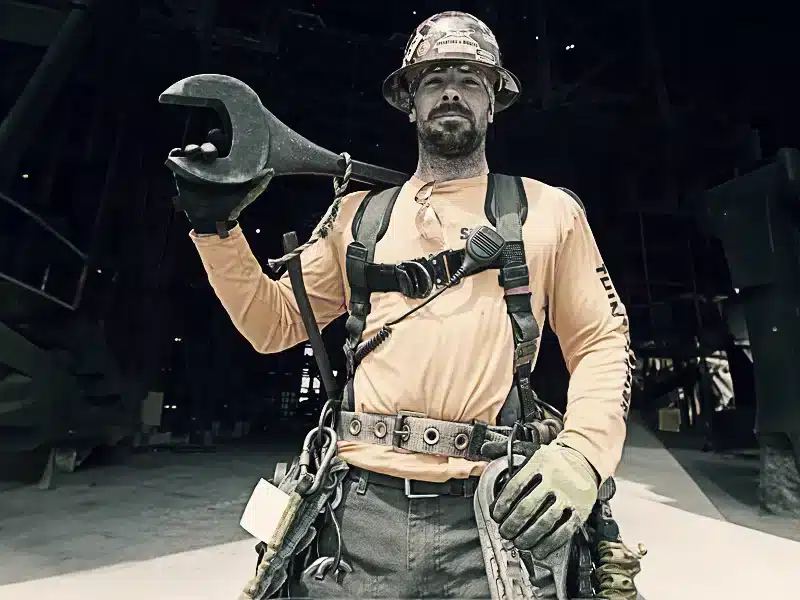
What is a Full Body Harness?
A full-body harness is not just a piece of equipment; it’s a lifeline for workers operating at heights. When a fall occurs, our harnesses distribute the fall forces evenly across the shoulders, thighs, and pelvis, minimizing the risk of severe injuries during a fall arrest situation. At FrenchCreek Fall Safety, we recognize the weight of our responsibility, which is why we dedicate ourselves to engineering full-body harnesses that meet and exceed the highest safety standards set by OSHA (Occupational Safety & Health Administration) and ANSI (American National Standards Institute).
Components of a Full Body Harness
Our full-body harnesses are designed with meticulous attention to detail, ensuring a perfect balance of comfort and functionality. Each harness consists of:

- Shoulder Straps: Designed to rest securely on the shoulders, providing stability and support during fall arrest.
- Leg Straps: Adjustable and comfortable, ensuring a secure fit without causing discomfort.
- Chest Strap: This strap adds an extra layer of security and helps prevent the harness from riding up during a fall.
- Dorsal D-ring: Located at the rear, it serves as the primary attachment point for fall arrest systems.
- Optional Hip D-rings: These versatile attachment points cater to specialized work applications, enhancing flexibility and efficiency.
Types of Full Body Harnesses
When it comes to full-body harnesses, the market offers a wide array of options, each tailored to meet specific application needs. At FrenchCreek Fall Safety, we understand that not all work environments are the same, and that’s why we provide a diverse range of full-body harnesses to suit various industries and job requirements. Examples include:
- General Construction Harnesses: Ideal for construction workers, these harnesses are designed to withstand the rigors of the construction site. They are engineered to provide comfort and support during extended use while offering reliable fall protection.
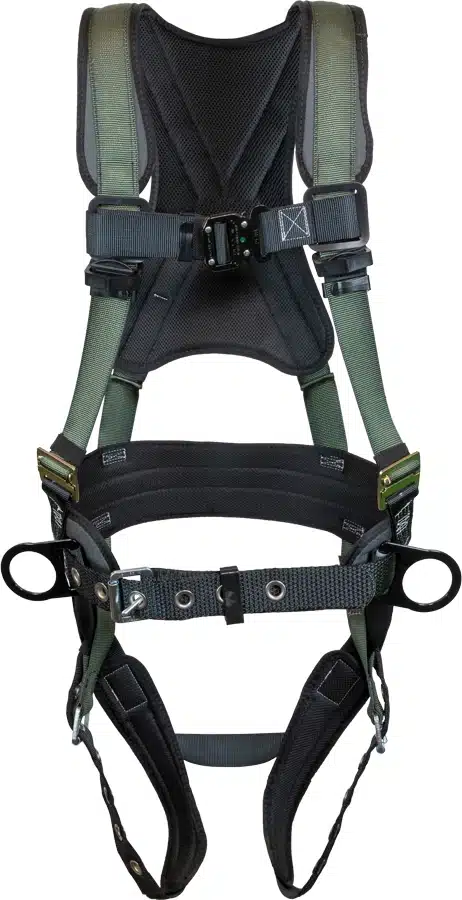
- Roofing harnesses are designed to be simple and lightweight, making them ideal for hot days when working on a roof. The absence of excessive padding allows for better ventilation, preventing unnecessary sweating and discomfort. These basic harnesses prioritize ease of use and mobility, ensuring that roofers can navigate freely and work efficiently without feeling weighed down.
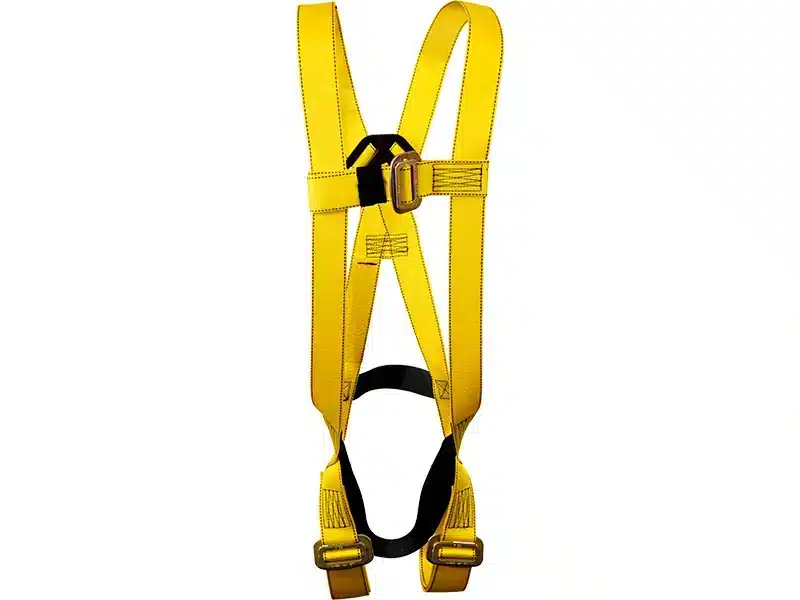
- Tower Climbing Harnesses: Tower climbers require specialized harnesses that offer maximum flexibility and mobility. These harnesses are lightweight and feature ergonomic designs to allow climbers to maneuver freely while working at heights.
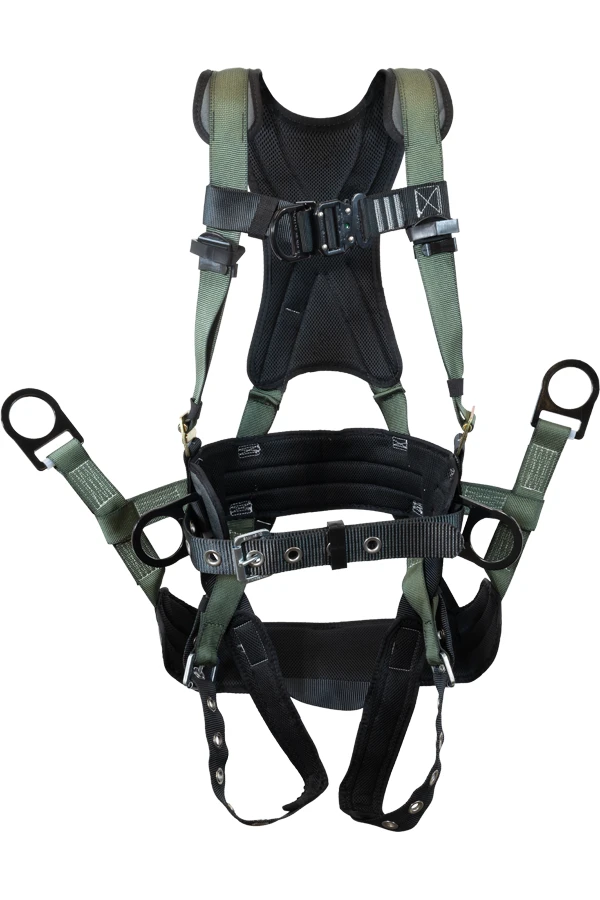
- Oil Rig Harnesses: Working on offshore oil rigs presents unique challenges, and our oil rig harnesses are designed specifically for this demanding environment. These harnesses include specialized features such as an oil derrick belly belt and a rear waist D-ring, providing added stability, support, and work positioning for tasks on derricks and elevated structures. The belly belt allows workers to securely position themselves on the monkey board while handling drill pipe and other equipment, distributing weight for comfort and enabling safe, stable operation during extended periods at height.
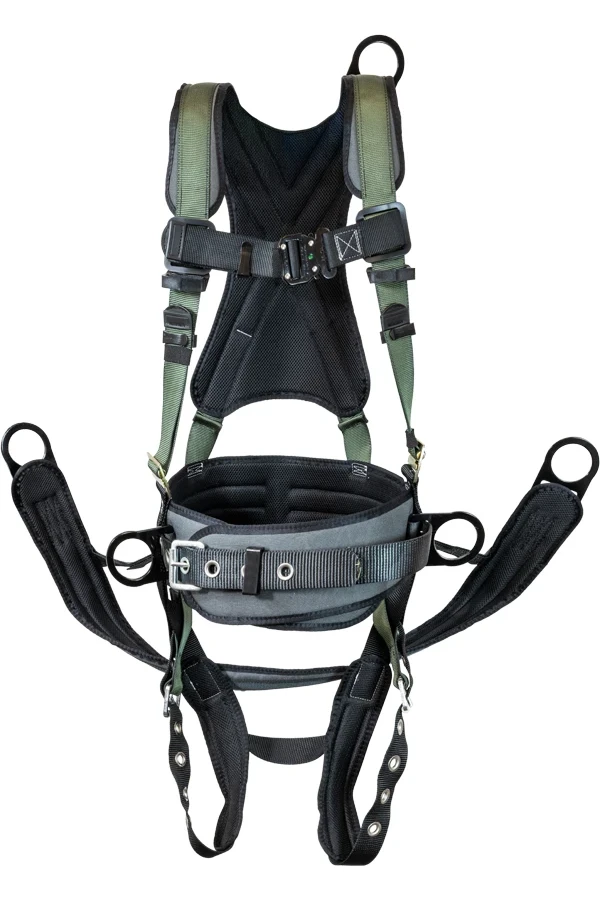
- Custom Harnesses: At FrenchCreek Fall Safety, we take pride in our commitment to meeting the unique needs and demands of various work environments. We understand that one size does not fit all when it comes to fall protection. That’s why we offer a wide range of custom harness options tailored to specific job requirements. Whether it’s specialized attachments, additional padding, or unique functionalities, our custom harnesses are designed to enhance performance and address the specific challenges of each work environment.
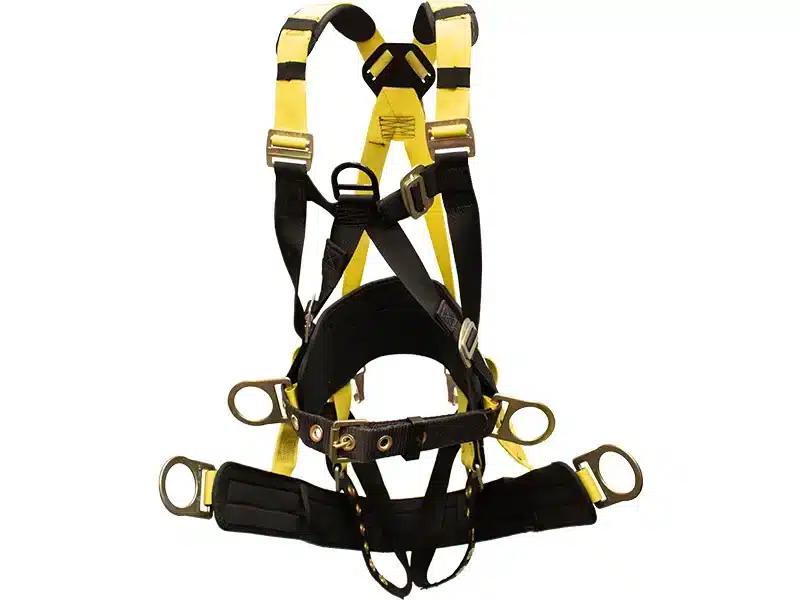
Selecting the Right Full Body Harness
Selecting the right full-body harness is crucial for optimal performance and safety. Here are some tips to consider when choosing your harness:
- Assessing Your Work Environment: Consider the type of work you will be performing; whether it involves construction, tower climbing, maintenance, or other specialized tasks. Each work scenario demands a different level of fall protection, and our wide range of harness options caters to diverse industries and job requirements. Furthermore, we understand that each job site may present its own set of challenges, such as uneven surfaces, confined spaces, or limited anchor points. Identifying these challenges allows us to tailor custom solutions that address your specific needs, providing you with the highest level of safety and comfort.
- Ensuring Proper Fit: A proper fit for your full body harness is paramount to your safety and well-being while working at heights. At FrenchCreek Fall Safety, we understand that a comfortable and snug fit is essential for optimal performance and confidence during your tasks. Properly adjusting all the straps of the harness is crucial to achieving the best fit possible. A poorly fitted harness may not distribute fall forces effectively, increasing the risk of injuries during a fall arrest situation. The improper fit can lead to concentrated pressure points, potentially causing bruising, strain, or even severe injuries to specific body parts.

- Comfort and Mobility: A comfortable harness is essential for workers to perform their tasks efficiently and with confidence, especially during extended work hours. One of the key features we incorporate into our harnesses is padded shoulder and leg straps. These padded straps are strategically placed to cushion the areas that experience the most pressure during wear. By reducing the pressure on the shoulders and thighs, our harnesses alleviate discomfort and prevent chafing, allowing you to focus solely on your work without unnecessary distractions.Comfort is not only about physical well-being but also about psychological well-being. When you feel comfortable in your harness, you gain a sense of ease and assurance, which positively impacts your mental state while working at heights. This boosts your confidence, enabling you to tackle challenging tasks with a clear and focused mind.
- Certification and Compliance: We recognize the significance of certifications and compliance in ensuring the highest level of safety for workers at elevated heights. When selecting a full-body harness, it is crucial to prioritize those that meet or exceed safety standards established by reputable organizations like OSHA (Occupational Safety & Health Administration) and ANSI (American National Standards Institute).Certifications from these respected entities indicate that the harness has undergone rigorous testing and evaluation to assess its performance and durability. Harnesses that comply with these standards are thoroughly assessed for their ability to provide reliable protection during fall arrest situations.
Inspecting Your Full Body Harness
At FrenchCreek Fall Safety, we emphasize the importance of regular inspection and maintenance to ensure that your full-body harness operates at its peak performance and provides reliable fall protection. Implementing a comprehensive inspection and maintenance routine is a proactive approach to safeguarding your safety while working at heights. 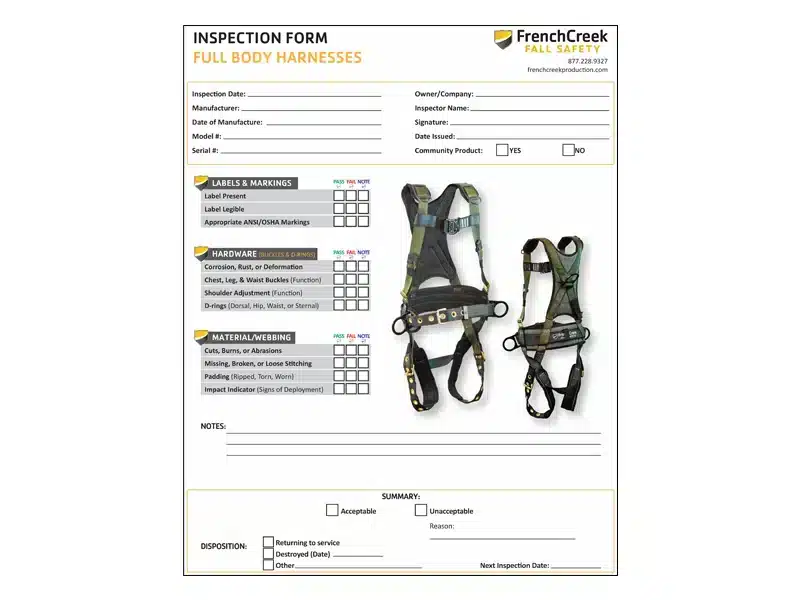
- Pre-Use Inspection: Before each use, conduct a thorough examination of your harness. Check for any signs of wear, damage, or deterioration on all components, including straps, buckles, and attachment points. Look for frayed webbing, broken stitches, or bent D-rings. If you discover any issues during the pre-use inspection, do not use the harness and replace it immediately. Never compromise on safety.
- Regular Maintenance: In addition to pre-use inspections, follow our recommended guidelines for regular maintenance. This includes cleaning your harness after each use to remove dirt, debris, and contaminants that may compromise its integrity. Use mild soap and water to clean the harness, and avoid harsh chemicals that could degrade the materials. Proper storage is also essential to maintain the harness’s longevity. Store it in a cool, dry place, away from direct sunlight and excessive heat.
- Inspection Records: Keeping detailed inspection records is vital to track the history of your harness’s condition. Note the dates of inspections, any identified issues, and actions taken. Regular inspection records not only aid in identifying patterns of wear but also demonstrate compliance with safety regulations and enhance accountability.
- Follow Manufacturer’s Instructions: Always follow the manufacturer’s instructions for inspection and maintenance, as different harness models may have specific requirements. Adhering to these guidelines ensures that you are maintaining your harness correctly and optimizing its lifespan.
By incorporating these inspection and maintenance practices into your routine, you can prolong the lifespan of your full-body harness and maintain its reliability. Download our full-body harness inspection sheet and read our additional resources on how to inspect a full-body harness.
Properly Donning Your Full Body Harness
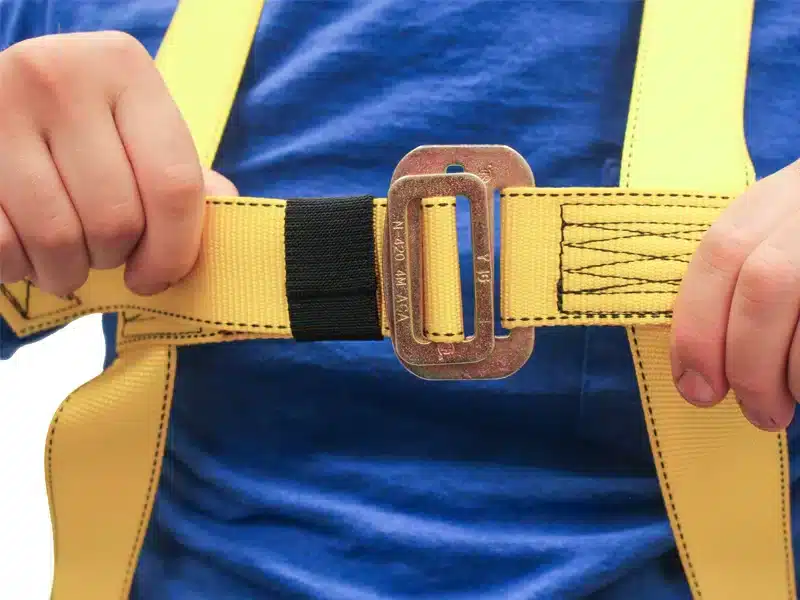
- Step-by-Step Donning Instructions: Always begin by consulting the manufacturer’s instructions for donning your specific harness model. Each harness may have unique features and adjustments, so it is essential to follow the provided guidelines precisely. Typically, the donning process involves slipping your arms through the shoulder straps and adjusting them to rest comfortably on your shoulders. Then, fasten the chest strap securely, ensuring it fits snugly but does not cause discomfort or restrict breathing. Next, fasten the leg straps, ensuring they are neither too tight nor too loose, providing a comfortable yet secure fit.
- Adjusting Straps for a Secure Fit: After donning the harness, take the time to adjust all the straps carefully. Achieving a secure fit is crucial to prevent the harness from slipping or shifting during use. Ensure that the shoulder straps are evenly tightened and that they lie flat against your shoulders without digging into your skin. The chest strap should be positioned across your chest, at the appropriate height, and the leg straps should be snug enough to prevent movement but not overly restrictive. By adjusting each strap correctly, you optimize the harness’s performance and ensure it functions as intended during fall arrest situations.
Customizations and Enhancements
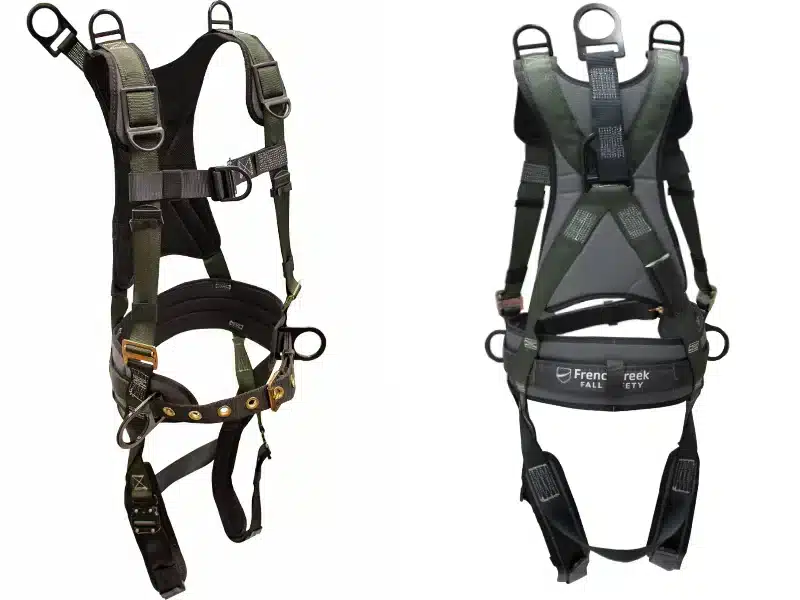
At FrenchCreek Fall Safety, we understand that each work environment is unique, and one-size-fits-all solutions may not suffice. That’s why we go the extra mile to provide tailored solutions to our customers. Our extensive range of full-body harness customizations and enhancements allows us to address specific industry requirements and individual work scenarios. If you need additional padding for enhanced comfort during extended use, our expert team can incorporate it into your harness design. If your job demands specialized attachment points or unique features for particular tasks, we’ve got you covered. Our commitment to customizations ensures that your harness is optimized for your specific needs, granting you the highest level of fall protection and confidence while working at heights.
Address Fall Protection Hazards
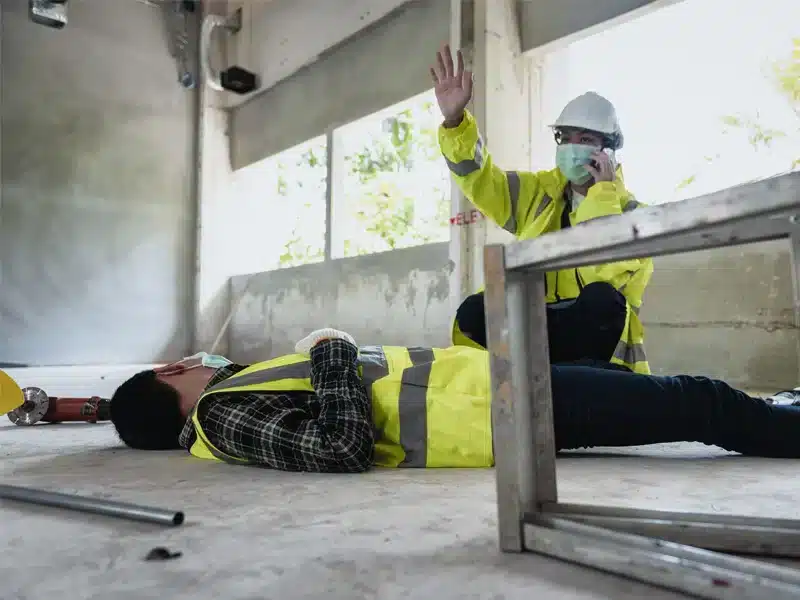
- Maintaining a Safe Work Area: Creating and maintaining a safe work area is essential for fall protection and overall workplace safety. Keep your work area tidy and organized, free of clutter and potential trip hazards. Store tools and equipment properly when not in use, and promptly remove any debris or obstacles that may obstruct your movement. A clean and unobstructed work area reduces the risk of accidental slips, trips, and falls, ensuring a safer working environment.
- Avoiding Swing Hazards: When working at heights, being mindful of swing hazards is crucial for your safety. Avoid working too close to structures, edges, or other obstacles that may cause swing injuries during a fall. Be conscious of your movements and positioning to prevent unnecessary swinging, which can lead to collisions or impact with nearby objects. Maintaining a safe distance from potential swing hazards minimizes the risk of additional injuries and fall-related incidents.
- Handling Suspension Trauma: In the event of a fall arrest, suspension trauma can pose a significant risk to your well-being. When hanging in a harness after a fall, blood can pool in your legs, leading to potential unconsciousness and serious health issues. It is vital to be aware of this risk and to follow proper procedures for self-rescue or prompt rescue by others. Training on suspension trauma awareness equips you with the knowledge and skills to mitigate the dangers of prolonged suspension and to take appropriate actions for self-rescue or prompt assistance from coworkers or emergency responders.
Training and Certification
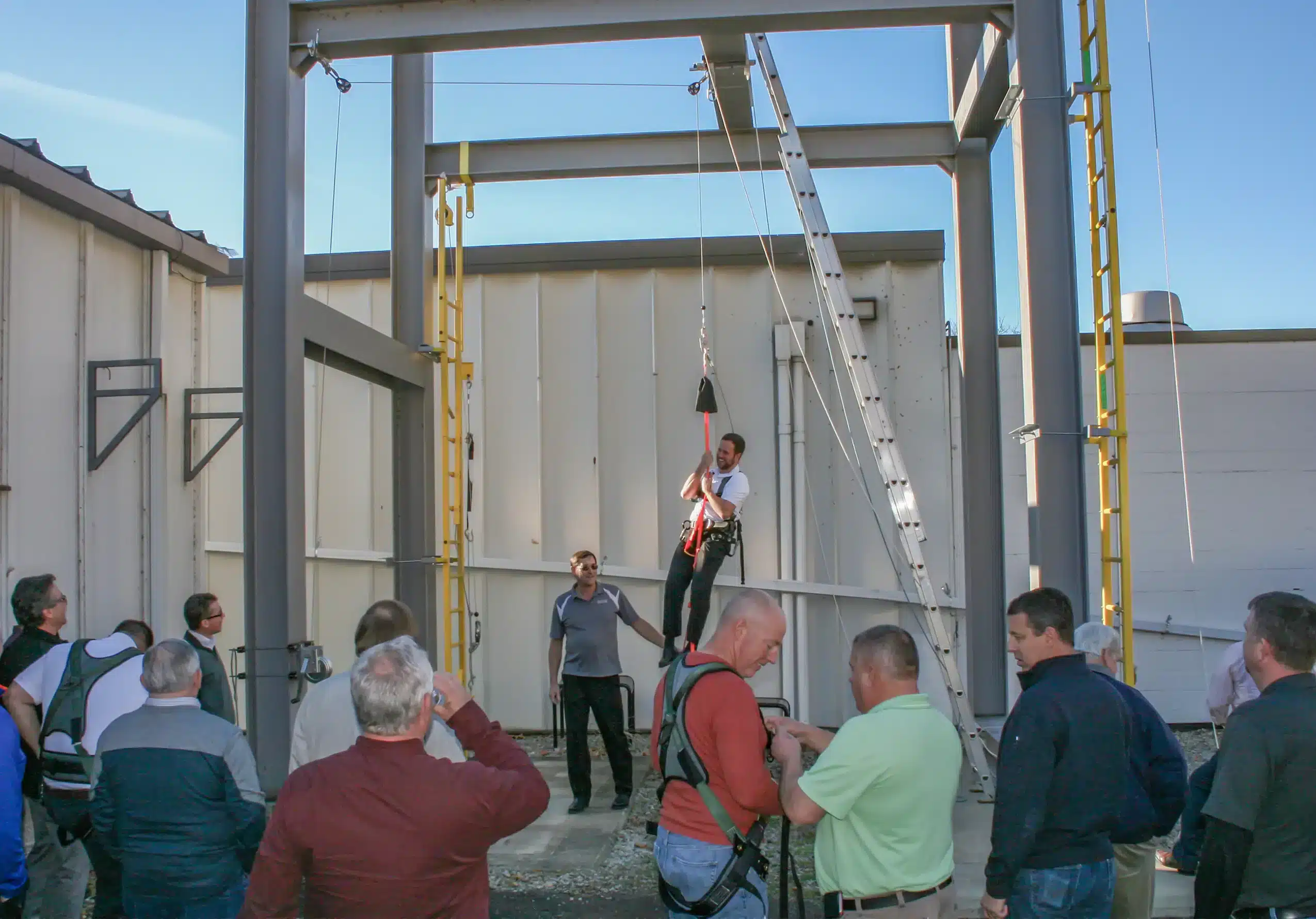
- Proper Training for Harness Use: Ensuring that all workers using full-body harnesses receive proper training is fundamental to their safety and competency while working at heights. Proper training includes comprehensive instruction on how to correctly don and adjust the harness for a secure fit. It covers understanding the different components of the harness and their functions, recognizing potential fall hazards, and practicing fall protection techniques. Additionally, harness inspection and maintenance training are essential to ensure that workers can identify signs of wear or damage and take appropriate actions to maintain their harnesses in optimal condition. Proper training not only enhances individual safety but also contributes to a safer work environment overall.
Frequently Asked Questions
- How often should I inspect my full-body harness?
- Perform a pre-use inspection before each use and conduct regular inspections as per the manufacturer’s guidelines.
- Can I use a damaged harness temporarily?
- No, never use a damaged harness. Replace it immediately to ensure your safety.
- What is the maximum lifespan of a full-body harness?
- The maximum lifespan varies depending on the harness type and usage. Follow the manufacturer’s recommendations for replacement.
- Is it necessary to have side D-rings on a full-body harness?
- Side D-rings are optional and are useful for specific work applications, such as positioning tasks.
- Can I use a fall arrest system as a restraint system?
- No, fall arrest systems are designed for fall arrest situations only. Use the appropriate restraint system for work positioning.
At FrenchCreek Fall Safety, we are dedicated to not only providing top-of-the-line fall protection equipment but also empowering workers with the knowledge and skills needed to work safely and confidently at elevated heights. We believe that a combination of proper training, awareness of potential hazards, and adherence to best practices is key to preventing accidents and ensuring a safe and productive work environment. Your safety is our priority, and we are committed to supporting you with the expertise and resources needed to achieve a secure and successful work experience.